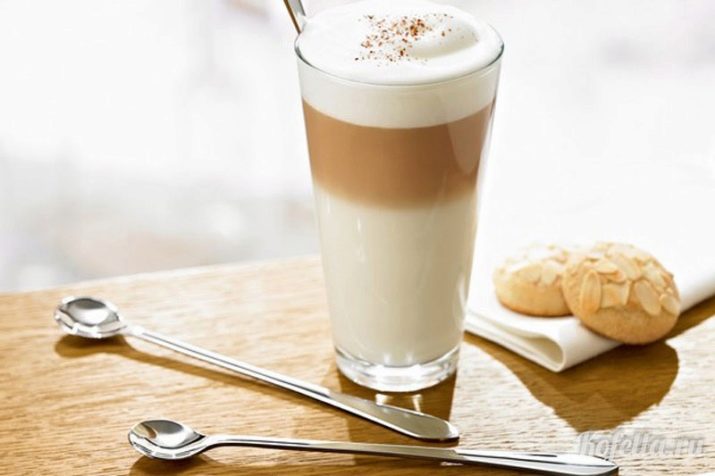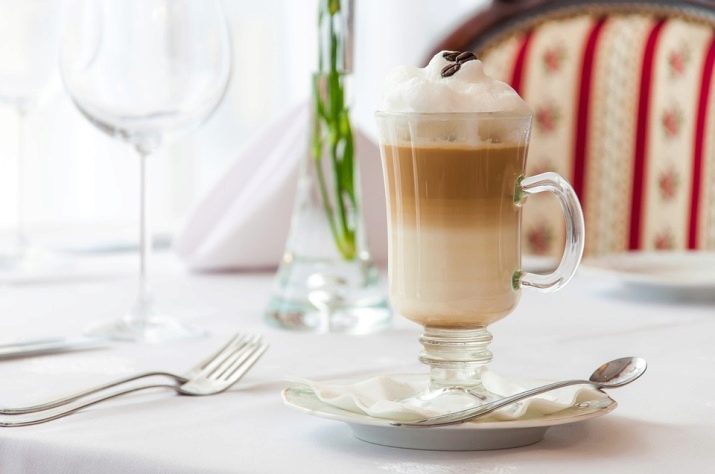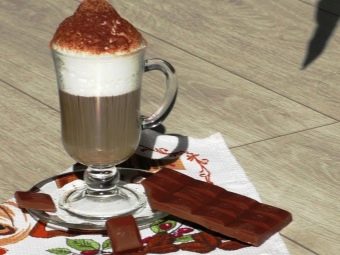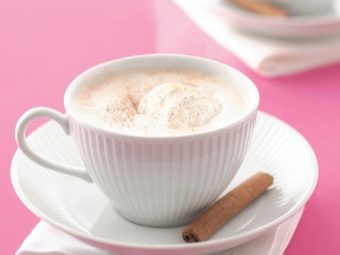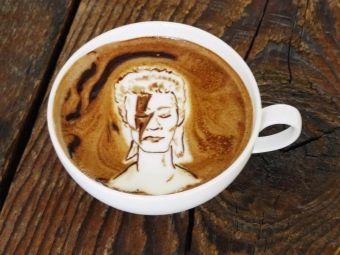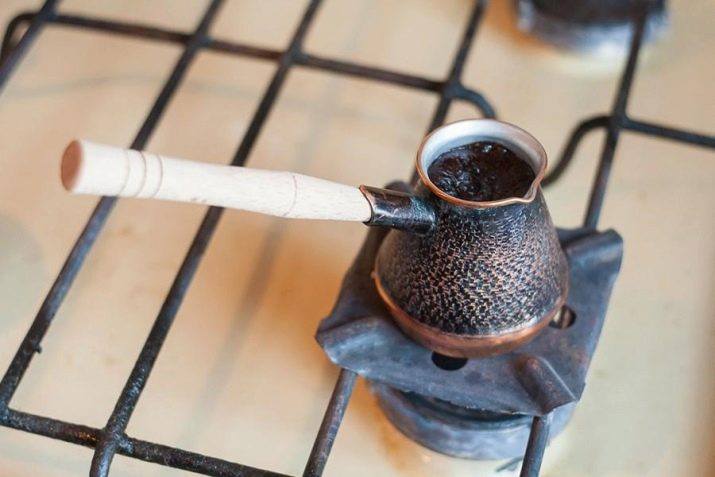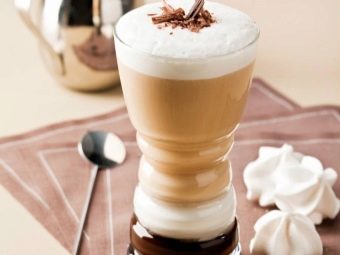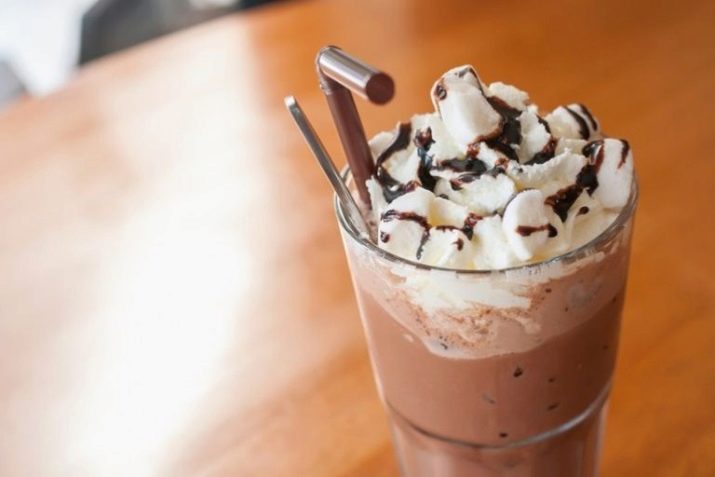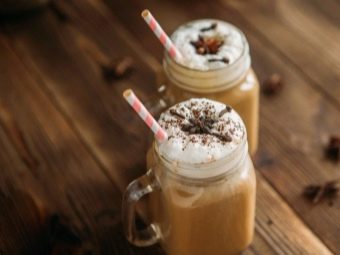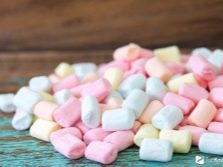Latte: the characteristic of the drink and its secrets
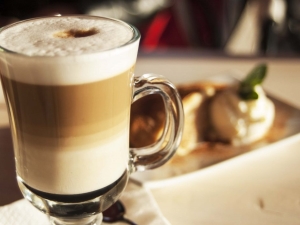
Latte was originally a children's drink, because it contained a minimum of coffee.A lot of interesting facts are connected with coffee latte, and due to the variability of its recipe it has many varieties.
Special features
Coffee Latte is a drink from a portion of espresso and two parts of milk that is whipped into a froth. The popularity of the latte is due to a mild taste with milky notes, as well as an appetizing serve.
From Italian, this name translates as "milk", which indirectly indicates the proportions of milk and coffee in this drink. The first clearly exceeds the second in terms of volume. By the way, if in an Italian cafe you just say “latte”, you will get ordinary milk. In this country, the correct way to say "coffee latte"
Homeland recipe is not installed, since this title claims several countries. So, in Italy they say that the name of the drink is clearly of Italian origin, therefore, probably, it was invented here. Initially, the name of the drink meant warmed milk, in which one day they decided to add a small amount of coffee for aroma.
The French retaliate that Latte originally sounds like cafe au lait and the drink is clearly of French origin. However, for the first time, milk from coffee was mixed on the territory of Austria - the Austrians politely remind themselves of themselves.
Whoever is the author of the drink, today he has gained popularity all over the world, and in many respects through the efforts of the Italian barista. They developed the flow chart of the drink and gave it a “name”. At the same time, the popularity of the drink in this country is not as high as in the world, which is connected with the constant love of Italians for strong types of coffee. They hereby consider espresso only.
The classic coffee latte recipe includes 2 components - espresso and whipped milk; sugar is added if desired and various sprinkles are made. Such a drink can be prepared only in a coffee machine, since the “right” espresso is prepared only there. And in the steam bleeder unit, you can beat the milk.
Espresso should be prepared with a short, no more than 30 seconds, extraction, which is provided only in the coffee machine. With this method of cooking, it acquires a rich taste and absorbs only nutrients, leaving tannins and carcinogens in the grains.
Cooking in a Turk, a coffee maker, or a french-jacket lasts longer than 30 seconds, so technologically this is no longer an espresso, although at home, in the absence of a coffee machine, it is prepared this way.
Let us return to the latte - it consists of 1 part espresso, two parts milk and a part of milk froth, which acts as a cap of the drink. The classical formulation suggests that 150 ml of foamed milk and 50 mg of milk foam is taken per 50 ml of espresso, that is, the volume of one serving is 250 ml.
However, the majority of specialized institutions increases the portion of the drink to 300-400 ml, and it is interesting that this is not about a corresponding increase in the proportions of all components. As a rule, this happens only with milk, the volume of espresso remains the same.
The correct name sounds like “latte” (emphasis on the first syllable in accordance with the rules of the Italian language), while most people in Russia and Europe speak French like “latte” (emphasis is placed on the last syllable), which is wrong from the point of view orthoepy.
What is the difference?
Despite the fact that cappuccino and latte are based on espresso and milk, and, if desired, granulated sugar, these are different drinks.
The differences relate primarily to the composition, since cappuccino contains 1 part of espresso and two parts of milk, while in coffee latte there is 4 parts of milk for one part of espresso. This causes a more pronounced milky-creamy taste of the latter.
Different cooking technology. First, for cappuccino milk is whipped into a more viscous, heavy foam, while for a latte it is filled with the maximum amount of bubbles, made with air. Secondly, cappuccino is milk poured into coffee. Lattes are prepared by pouring coffee into the milk.
Finally, the level of caffeine in drinks is also different - in a cappuccino it is more, because espresso is taken in a larger volume. Up to 100 ml cappuccino can be used per 200 ml of milk, while only 50 ml in latte.
Due to the similarity of the composition with a latte, coffee-raf is sometimes confused, however, on a closer look at the composition and preparation technology, it turns out that these are completely different drinks.
For coffee-raff is also used espresso in the amount of 25 ml. To this volume adds 100 ml of warm non-fat cream (maximum fat content - 11-15%). Another essential ingredient is sugar, and a part of it is vanilla sweetness. Usually takes 1 teaspoon of regular and vanilla sugar.
The second difference is in cooking technology. If it is important for a latte to get a layered structure (even if it is not so pronounced now), then coffee raf assumes joint beating of all the ingredients using a coffee maker, cappuccinator or blender.
This beverage is related to the fact that the taste of coffee is felt in them to a lesser degree than in cappuccino. They have a milder shade, and coffee appears, rather, as a flavoring and emphasizes the overall taste of the drink.
Types and their calories
The popularity of the drink and the relative freedom of action in its preparation have led to the emergence of several varieties of coffee latte. Perhaps the most famous is mochiato, which implies a clear layer structure. Mochiato and translated as "spotted." In the drink, not only is the border between espresso and milk clearly traced, but the latter, in turn, is divided into 3 layers due to the difference in heat and density.
Fame acquired and latte mocha. It is easy to guess that this is a drink that combines the ingredients and tastes of latte and mokacho. The latter is prepared on the basis of espresso, hot chocolate, milk and cream, taken in equal volumes. Late mocha includes espresso and hot chocolate (the latter can have the appearance of a syrup and be added directly to coffee), whipped milk and cream “cap”. It is usually decorated with topping, chocolate or coconut chips.
Adding certain ingredients can significantly change the taste of the drink. Among the most popular supplements are syrups. First of all blueberry, nutty, chocolate, vanilla. They are poured as a first layer of latte or mixed with coffee.
In the summer heat, ice latte is popular, which is prepared on the basis of chilled espresso, sometimes adding ice cubes to a glass. Latte with ice cream has a cooling effect.
The opposite warming effect gives a drink with spices or alcohol. The first is mixed with coffee or milk, after which the latte is prepared in the usual way. Alcohol is usually poured, like syrup, the first layer on the bottom of the glass. Some of its species are pre-cooled.
The drink has become so widely known throughout the world that even its variations based on tea have appeared. So, in Africa there is a latte based on roybos (red herbal tea) with milk, and in Latin America - a similar milk drink with mate (also a type of tea).
Separately, it is worth highlighting such a direction in the preparation of a drink as a latte art, that is, the decoration of the upper layer with drawings and patterns. Any kind of latte (usually classic) can be decorated in this way.
As paints, melted chocolate is often used, which is poured drop by drop onto the foam and stretched into the pattern with the help of a pointed object. This technique is called "etching." If you pour black coffee from a special dish with a thin spout over the dairy “cap”, the method is called “pitching”. This is one of the most complex techniques, which requires primarily the presence of artistic abilities. Professionals usually use both techniques simultaneously, working in a mixed technique.
Without skills in latte art, you can use stencils. On a piece of paper, you need to draw and cut the desired pattern, then attach it to a cup of coffee and sprinkle with stencil place grated chocolate or cocoa powder, coconut chips. Minor flaws of the pattern on the skin are corrected with the help of a pointed stick or tubule.
A relatively recently appeared 3D-technology, involving the creation of volumetric figures from milk froth. For this, masters prepare more foam and, as a rule, beat it longer to achieve maximum stability.
Latte art is a vast area that has become even a competition. Professional baroists and coffee artists gather at championships where they demonstrate their skills.
By the way, it is believed that the latte drawing on coffee can change its taste. So, the popular stretch of milk in the shape of a heart makes coffee a bit more bitter. This is due to the fact that the foam disperses to the walls of the glass. But the painted leaf, on the contrary, implies a contraction of the foam in the center, due to which the milk is felt to a greater extent at the throat and the taste of the drink seems softer.
The calorie content of a drink is determined by the volume and fat content of milk or cream, as well as the presence and amount of additives (sugar, dressing, syrup).
Classic latte (for whipping, milk is usually used with a fat content of 3.2%) contains 116-118 calories (kcal).
Do not forget that more and more often cafes and coffee houses serve lattes of increased volume. If in a standard portion of 250 ml to use less fat milk (2.5%), then its energy value decreases to 109-110 kcal. When mixing cream 10% and milk with a fat content of 2.5%, the latte has a calorific value of 175 kcal per 100 grams.
Many prefer to sweeten the drink. One teaspoon of sugar increases its calorie content by 20 kcal.
The presence of cream in the form of "caps", grated chocolate, toppings, cocoa powder significantly increases the calorie content of the drink. If we talk about such a latte, served in specialized establishments, then its energy value can reach 400-500 kcal. For most people, this is the calorie content of a full meal or lunch.
Taste qualities
Latte is more appropriately called a coffee-based drink. The latter is present only as a flavoring agent, its hue is practically not felt in the drink. The creamy milk chords come to the fore. The milky tenderness is also emphasized by the structure of this layer - bubbles are similar to those found in an oxygen cocktail. Due to this, the texture of milk is airy, friable.
If you compare the taste of latte with the taste of cappuccino, then in the latter one can clearly feel the coffee, characteristic nutty aftertaste for it. Milk in cappuccino emphasizes the rich taste of coffee, while in latte the opposite is true - coffee is set off by a creamy milky taste.
Cappuccino foam is denser, more painful, it stays longer in the mouth. Because of its consistency, it holds sugar, chocolate, and sprinkles well. "Cap" latte itself is an ornament and because of the delicate structure is bad keeps other additives.
Cooking technology
Making a latte with a classic recipe is quite simple. To do this, boil 50 ml of espresso. It is better to do this in a coffee machine, but if it is not there, a Turk will do.
Grains for espresso better grind before cooking, so they will retain their taste and aroma. The degree of grinding is recommended to determine tactile - the resulting mixture should resemble sea sand or fine salt.
For lattes, it is recommended to brew coffee from soft arabica. It is recommended to refuse from use in the composition of Robusta or to introduce it no more than 20-25%. It will take 2 teaspoons of this mixture.
If espresso is brewed in a coffee machine with manual dosing of water, then 7-10 ml of ground coffee should be placed in a holder, and then sealed with a tempera. It remains to press the "Start" button, choosing the grain extraction time not more than 25-30 seconds.
In models with an automatic water supply, the process of preparing the basis for a latte looks the same, but the liquid is supplied in an automatic mode. The easiest way is to prepare coffee in automatic units, since it suffices to select the appropriate program and press the "Start" button.
Despite the fact that the finished espresso will not be served in the cup, but will be poured into the milk, it is recommended to pre-heat the dishes for it. This will allow the taste and aroma of the drink to open up better.
If coffee is brewed at home in the Turk, then for a brighter coffee taste of the grain, you can warm up a little at the bottom, and also throw a pinch of salt there (do not worry, it will not be felt in the finished drink). After the grains heat up and begin to give off more flavor, you need to fill them with 50 ml of cold water, then warm the coffee until foam appears. It is important not to overdo the drink, do not let it boil.
Some people prefer to remove a Turk from a fire 2-3 times after foam appears on the surface of the coffee. After waiting for the foam to settle, the drink is returned to the stove again. It is believed that you can cook the "right" espresso.
It is up to everyone to do the same or immediately after the foam appears. One cannot say that one of the methods is better, since a real espresso requires preparation in a coffee machine.
Variants of cooking in the Turk are, rather, variations of this drink.
At this time you need to prepare the milk. It is optimal to take a product with a fat content of at least 3.2%, because it provides the velvety and delicate taste of latte. If you use a low-fat product, it will not scramble into a soft crema, and the coffee will turn out watery. You can mix milk with heavy cream, taking the ingredients in equal amounts.
To whip milk and cream, they should be preheated. 1.5-2 minutes in the microwave for this will be quite enough. The temperature of the product should reach 30-40 degrees.
It is better to beat the milk in the steam dispenser of the coffee machine, using a cappuccinator or blender. As a result, a loose foam should appear, filled with air bubbles. It is important not to miss this point, because with prolonged beating, the foam is more viscous, which is not suitable for lattes.
Now, whipped milk is poured into a cup or tall glass, after which espresso is poured along the walls. As a result of these manipulations, the coffee is at the bottom, and the air "cap" rises to the top.
Latte goes well with weak alcoholic beverages with a velvety, better creamy taste. Knowing this, you can make latte with Baileys liqueur, which will require the following ingredients:
- 1 teaspoon ground coffee;
- 1 teaspoon of granulated sugar (a little less, if you are not a sweet tooth);
- 80 ml of water;
- a pinch of salt and cocoa;
- a glass of milk with fat content of more than 3.2%;
- A tablespoon of Beilis liqueur (or similar).
First of all, you need to prepare a clear glass - heat it up. After that, “Baileys” is poured into the bottom of the glass, and then the milk is preheated and beaten to the desired consistency.
At the same time, you need to brew coffee, for greater saturation of which a pinch of salt rushes to the bottom of the cezve, and the ground beans are preheated.
An espresso pours into the glass in a thin stream, causing the milk foam to rise to the top. Using a stencil on the surface of the "cap" is applied to the drawing of cocoa. For the first time it is better to choose a simple image of a simple form. You can correct minor contour inaccuracies with the help of a straw.
Instead of liqueur "Baileys" you can use Irish Syrup Irish Cream. The latter is a product based on Irish whiskey and cream (or based on these ingredients) with a pronounced caramel tint.
It will need 50 ml. Achieve stratification of the drink allows pre-cooling of the syrup. Irish Cream is poured into a tall transparent glass.The second layer should be 100 ml of milk whipped into foam with a fat content of at least 2.5%. Another 100 ml of milk must be heated, but not whipped. Divide into 2 parts and 100 ml of a conveniently brewed espresso.
After that, mix the hot milk and half of the espresso and pour it into the glass along the walls. This will be the third layer. Fourth - the rest of the espresso. If everything is done correctly, the milk froth will rise up, forming the fifth layer. As a decoration, you can choose grated chocolate or ground cinnamon.
Emphasize the rich taste of espresso, the delicate and airy structure of the milk, which is in itself a bright blueberry syrup. The result is an original drink with a bright authentic taste.
You can prepare it as follows. Take 50 ml of blueberry syrup and, after cooling it down, pour it on the bottom of a transparent glass. Then heat 50 ml of milk, add 5-10 ml of blueberry syrup to it (it is needed here to get a light blueberry hue, so you can adjust the amount of syrup based on your wishes about the final appearance of the drink) and beat the milky blueberry mixture until a frothy foam. It will be the second layer of coffee. The third layer - carefully poured freshly brewed espresso.
In this recipe, the latte cap is whipped separately, because when mixed with blueberry syrup, the milk does not rise over the coffee (as it gets heavier), and its color does not fit. For beating, use 50 ml of milk with a fat content of at least 2.5%. The resulting foam is placed on top of the espresso. You can decorate the drink with chocolate topping or chips.
In the summer heat, it's nice to drink ice latte with ice. To prepare such a drink is not difficult. First you need to cook 60 ml of espresso, then pour into it 10 ml of chocolate and 5 ml of vanilla syrups.
Put ice cubes on the bottom of a high glass (5-6 will be enough), pour out the milk heated in foam and foamed (110 ml with a fat content of 2.5 or 3.2%). Finish the process of preparation by pouring a thin stream of aromatic espresso.
Another option is a latte with ice cream. First you need to cook an espresso from a teaspoon of ground beans and 60 ml of water. Then 150 ml of milk are whipped, which is poured into a glass. A thin stream of freshly brewed coffee is added to the dishes.
The ball of ice cream is laid out last in a glass with a drink and decorated with cocoa powder or grated chocolate.
In winter, on the contrary, you can make hot latte coffee more spicy and warming by adding spices to it. Mince ginger, cinnamon, cloves, nutmeg combine well with the drink. It is important that these spices are harmoniously combined with each other, so you can use them not one by one, in the "company".
Spices, like coffee, it is better to grind on their own just before adding to the drink.
Spicy latte involves the use of 60 ml of espresso, 120 ml of milk whipped into the foam and half a teaspoon of spices. The latter are brewed with coffee, if the latter is cooked in the Turk, or warmed with milk, when the espresso is brewed in a coffee machine. The rest of the cooking technology does not differ from the classical. As a decoration, you can use clove stars or vanilla sticks.
Fans of sweet, powdered coffee drinks will appreciate caramel latte. First of all, boil 95 ml of espresso and add 20 ml of caramel syrup there. In another container, beat the heated milk, taken in a volume of 210 ml. Separately, also beat in a lush foam (up to peaks) 20 ml of cream.
Coffee with syrup is poured into a glass or a ceramic cup, then frothed milk completes the cooking with a cream cap.
Another latte coffee recipe, claiming to be the classic one, with marshmallows or marshmallows. The latter is preferable for American culture, where this drink originated. These are different sweets - the marshmallow is more cloying and friable, with eggs in its composition.
You can decorate with a sweet classic latte or make a special drink with honey, spices and marshmallows. To do this, boil 120 ml of espresso and mix it with honey (2 tablespoons) and cinnamon (one third teaspoon). Preheat 240 ml of milk and whip it into a froth, then pour it into a tall glass made of transparent glass. Carefully introduce coffee with honey and cinnamon, wait until the foam rises to the top. Decorate with marshmallows or marshmallows.
Authentic latte recipes delight with their authentic taste. Some people are delighted, others are puzzled, but they are worth trying in preparation. One of these recipes is pumpkin syrup latte.
To translate it, you need to take 90 g of pumpkin pulp, chop it and, after pouring 80 ml of water, boil over moderate heat for 15-20 minutes.
The amount of water may be a little less or more, adjust it to ensure that the pumpkin is not burnt.
After a specified time, when the pumpkin becomes softer, it is pursed with a blender, 50 g sugar and half a spoonful of ground cinnamon are added to it, and then returned to the fire for another 10 minutes. The result is a fragrant and beautiful pumpkin syrup that needs to be cooled.
The cooled syrup is poured onto the bottom of the coffee glass, the second layer is added with 400 ml of whipped milk, and then 210 ml of freshly brewed espresso is poured. As decoration, you can use pumpkin seeds, cinnamon.
Another interesting recipe is lemon-mint latte. Cooking it begins with boiling 95 ml of espresso. To it add 1 tablespoon of lemon juice and a couple of slices of fruit.
The resulting mixture is poured into a suitable glass. 210 ml of milk with fat content of at least 3.2% is combined with 1 teaspoon of sugar, heated and whipped until foam appears. Ready sweet milk is poured over coffee. As a decor, you can use cream cream. Be sure to put mint leaves on top of the milk or cream before serving.
Filing rules
For a long time, one of the ways to demonstrate the skill of a barista remained the ability to preserve the layering of the drink as much as possible. A tall glass made of transparent glass allowed her to demonstrate it.
Initially, a cone-shaped transparent glass on a stand with a handle was used. If a glass for ayrish had a leg, then such dishes were attached directly to the stand. Then this glass was replaced by a more democratic-looking. Today it is a tall glass in the shape of a truncated cone. The fact that it serves and hot, can only be through the greater thickness of the glass and a massive bottom.
Today, fashion trends are somewhat different, and latte coffee is served in a regular ceramic cup.
The decoration of the democratic supply is milk froth, on which sometimes chocolate (most often) or other dressing rises.
As a rule, small spoons with long handles are served to cups and glasses. The use of ordinary tea or coffee is impractical because of the larger volume of drink. Instead of saucers, coasters are used.
Cups and glasses are preheated, and the drink is poured into them hot and served immediately.
In some cases, on the surface of the skin of the barista make drawings and patterns. However, more often they can be found on a more elastic cappuccino “cap”, which also does not require mixing.
It is believed that if coffee art takes place on the surface of coffee, it is drunk through a straw or from a cup, without disturbing the design.
However, if you have a need to put sugar in the drink, you can safely do it and mix the coffee, having admired the drawing a little. Violation of etiquette will not.
How and with what to drink?
Italians call latte coffee a drink of the first half of the day and prefer to consume it before lunch. They believe that drinking latte, like any milk-containing drink, is fraught with digestive disorders at a later time.
Because of the high energy value, lattes are not recommended immediately after the meal.The exception is coffee for breakfast. It can be an excellent addition to the classic morning meal and will allow you to feel more cheerful.
Latte, especially with the addition of syrups and toppings, is quite nourishing and high-calorie drink. However, if we talk about suitable desserts, then those of coffee will be light fruit and cream, curd desserts, baskets with cream and fruit, cheesecakes. The milky taste of the drink will emphasize desserts based on nuts, cheese, caramel.
Tips
One of the secrets of making delicious coffee latte is the proper preparation of milk. As already mentioned, to obtain the desired foam consistency, you should use a product with a fat content of at least 3.2%. A leaner version will cause the wateriness of the drink and will not allow foam to be obtained.
For lactose intolerance, you can use soy or coconut milk, the main thing is not to choose products with a low fat content.. Before beating, you should heat the milk in a convenient way to 30-40 degrees.
If you are cooking latte at home and do not have a coffee machine or cappuccino maker on hand to froth milk, use an immersion blender. Depending on its power, whipping time will be 2-5 minutes. It is believed that the best milk is whipped in an aluminum pan.
If the kitchen does not have a blender, you can try to beat the milk with a french press. To do this, the heated product is poured into the flask, closed with a lid, after which it is necessary to move the press vigorously up and down. The result should also be a layered and high foam.
When making a latte with syrup, be responsible for choosing the latter. Some berry, fruit, including popular citrus fruits, contribute to the folding of milk, and therefore are not used. Preference should be given to cream, chocolate, caramel syrups.
The taste of latte also affects the degree of grinding of coffee beans. If you grind them too small, then the finished drink will turn out too strong, it will feel bitterness. An excessively large coffee mass will not retain water, so the latter will quickly spill through the pressed coffee in the coffee machine and the drink will turn out to be “empty”, it will not contain a light coffee aftertaste.
The brownish foam characteristic of espresso is also evidence of the correctness of the selected degree of grinding. Ideally, it has a reddish shade, its surface is speckled with streaks, but the main mass of coffee is not visible through it. Too dark foam indicates that the grinding is too fine, or the grain is taken in abundance, light - about a large degree of grinding.
The degree of roasting is also important. Latte recommended minimum roast grains. Then the taste of the drink is more tender and soft.
When you pour the espresso into the prepared whipped milk, it should be done carefully, pouring it along the wall of the glass. This will allow the ingredients to not mix, and more easy "cap" to go up.
In the traditional recipe, the ratio of coffee and milk looks like 1: 3 or 1: 4. Initially, by the way, it was invented for children (coffee acted as a flavoring and set off the taste of milk), so the latte is considered safe. The caffeine content in it is low, so in moderation it is possible for pregnant women, people suffering from hypertension, and it is also not forbidden to use it in the afternoon and even a couple of hours before going to bed.
You can find out how to make lattes in the next video.

